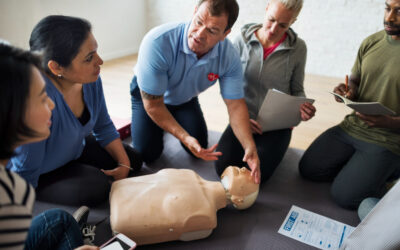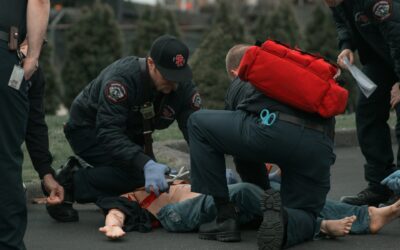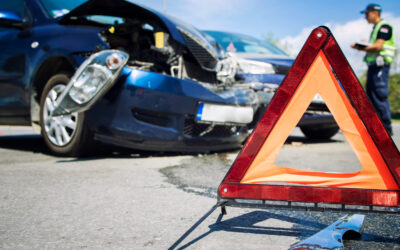Your team is treating a critical patient en route to the hospital—scribbling notes on a clipboard or even on a piece of tape on their leg. They must remember everything about the event and all actions taken, then share that information with hospital personnel, and then rewrite everything carefully into an official log, especially tracking the use of narcotics like fentanyl.
It’s a high-stress situation with a lot of moving pieces.
Emergency responders are subject to extreme scrutiny while working with controlled substances, particularly narcotics, but there’s still room for error in a busy, hectic environment. Tracking narcotics on paper leaves many gaps that can lead to major problems for any department or organization.
So how can EMS teams practice due diligence with controlled substance tracking? Is tracking narcotics on paper really the best answer or is there a smarter narcotics-tracking system?
The Many Risks of Tracking Narcotics on Paper
At the heart of every emergency medical responder is a strong desire to help others. But in this high-stress, high-adrenaline environment, EMTs and first responders are subject to extreme pressure. We take on this role, including rigorous multilevel training and a high learning curve, because we’re driven by dedication. Pushing through 12 and even 24-hour shifts requires fortitude and a tough constitution.
Unfortunately, through all the chaos, people can make errors both in judgement and in recording.
Diversion—controlled substances that end up untracked or missing—is an extreme concern for anyone working in EMS. Even if team members’ intentions aren’t nefarious, distraction, inattentiveness, and exhaustion can lead to diversion, mistakes, and patient suffering, which all of us want to avoid whenever possible.
The United States Drug Enforcement Administration (DEA) requires handlers of controlled substances like narcotics to undergo rigorous training and reporting. Every dose and usage must be carefully recorded and logged, whether you use narcotics tracking software or pen and paper. Having the right systems and tools to protect and help your team do the best job possible is crucial to the success of your entire operation and the health of the patients you serve, especially when the slightest error can be dire.
Even when the quality of patient care isn’t at stake, losing track of any narcotics can lead to investigations and fines. It can ultimately cost your organization the ability to carry controlled substances in the future. That’s a significant problem. Penalties for not meeting the DEA’s narcotics tracking requirements can be upwards of $20,000 and include serious legal consequences. This is a heavy blow to bear for a department, public or private, that likely runs on a shoestring budget.
When it comes to tracking narcotics on paper, it’s a big job that can give way to complacency. Often, stress and hurriedness can lead to a staff member signing-off on a paper narcotic tracking sheet without doing their due diligence to walk through each and every item. Many EMS workers are tired and eager to get rest and recharge after a 12-hour (or longer) shift. It’s not uncommon to see several days of paper documentation pass before a diversion problem is noticed. Signing-off becomes routine, and it’s simply easier to become hasty in your approach with paper.
Plus, tracking narcotics on paper is time-consuming. For example, medical directors might oversee 20 agencies—so narcotics auditing requires physically going around to each agency and checking every narcotics tracking sheet. These activities often take days out of your month, adding tons of travel and documentation to an already busy job.
Tracking narcotics on paper is like driving without a seatbelt. Yes, it can work. You might be fine and safe, but if something goes wrong, it’s too late to do something about it.
What if there was an easier solution designed to reduce your risk?
LogRx: The Affordable Solution for More Accurate Narcotics Tracking
With LogRx, there’s a better way to track narcotics. LogRx was designed by emergency responders who understand what it’s like to have boots on the ground during real-life emergencies. Our team has years and years of EMS experience, so we understand oversight requirements (and where gaps can show up).
LogRx offers reporting in real-time as your team reports their usage. They can document when and where the narcotic was administered with a simple scan. No special hardware is required to use LogRx—your team uses their existing mobile device or tablet—so LogRx is a very affordable option, especially compared to other narcotics and controlled substance tracking systems.
To use this simple, tamper-evident controlled substance management system, you simply open the app and get started. EMS teams scan drugs from anywhere using our purpose-built QR codes. The EMS worker interface is a simple two-button layout, minimizing room for error.
LogRx tracks each use recorded, allowing you to manage inventory and check supplies with real-time visibility. On the admin level, you can access all needed data for reporting, tracking, and monitoring the integrity of your narcotic supply. Remote monitoring allows you to check medication use and track all information you need for DEA compliance, reporting, and narcotic tracking—from your computer. Instead of dealing with compiling and sorting through paper narcotics tracking, you can quickly run cloud-based reports.
LogRx dramatically increases narcotics tracking accuracy, protects staff time, and preserves the reputation of your agency. Most importantly, though, it protects patients by allowing you to focus on their care rather than worrying about the logistics of tracking narcotics on paper.
Many of our users report that LogRx is like having an extra staff member. It saves so much time that would be spent gathering paper reports, visiting various locations, and checking and rechecking logs. LogRx makes narcotics tracking easy and convenient.
Fighting Complacency, Protecting Patients
The biggest issue with tracking narcotics on paper is complacency. Team members often become lax on their tracking systems—not because they don’t care, but because tracking on a paper narcotics tracking sheet isn’t convenient in a busy, stressful environment.
Diversion can happen intentionally or unintentionally from an inside employee or an outside vendor, but when it happens, you need to be sure you have all proper tracking in place. We’ve seen many instances where EMS organizations discovered a drug diversion, only to realize logs hadn’t been filled out for weeks or months prior to discovering the problem. Every time there’s a shift change or controlled substances change hands, staff must track them. Unfortunately, there’s a tendency to “pencil-whip it” and quickly sign off.
In one case, a large supply of narcotics was misplaced when a fire department sent a unit in for service. After several days and a fruitless review of paper records, the team discovered the medication inside the ambulance at the mechanic shop. Again, not because of bad intentions, but because of poor tracking. Paper tracking of narcotics and controlled substances leaves too much room for human error.
Monitoring and tracking waste, keeping a hand on inventory, and knowing exactly where your controlled substances are at all times, is vital. LogRx helps you track when even a portion of a vial was used and how it was disposed of. When patients need medication to ease their pain and help them during an emergency, you want to ensure your inventory is accurate, protected, and compliant with all the DEA guidelines.
LogRx allows you to view your team users and get an overview comparing the frequency of dispensing. This feature can help you track inventory and quickly become aware of shortages or abnormalities. Often, dispensing styles vary amongst practitioners—and while most policies allow for variation, with LogRx tracking, you can identify patterns and detect use outside normal parameters.
No matter your medication stocking style, LogRx can help you keep track of where your controlled substances are at all times. Some keep their meds in a safe at the station, replenishing them every 12 hours during shift change. Other EMS organizations fill drug boxes within the unit after 24-hour shifts. Others get narcotics and controlled substances in a tamper-proof bag from the hospital. LogRx offers a flexible and customizable narcotics tracking solution for all three methods.
Medication compliance and controlled substances monitoring aren’t procrastination-friendly jobs. When there’s a problem, consequences go all the way to the top. Unfortunately, the medical director, staff, and everyone in the organization can pay the price. Not only can it be a PR nightmare (especially for publicly funded institutions), but it can lead to a loss of licensure, fines, and fallout for patients as well.
Protect yourself and your patients with a narcotics tracking system that works efficiently, seamlessly, and accurately. LogRx is an affordable, user-friendly solution designed to minimize your risk and help your staff excel at patient care every day.
For more information about this powerful controlled substance tracking tool, please contact us. Our team works with public and private EMS organizations, psychiatric practitioners, veterinary medicine providers, and any medical practice looking for a better way to log and track controlled substance dispensing.





